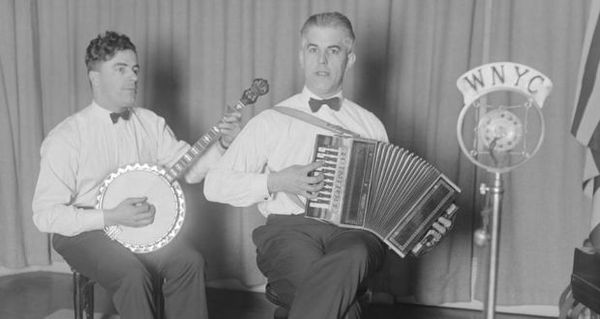Annotation:Flanagan's Jig (2): Difference between revisions
m (Text replace - "[[{{BASEPAGENAME}}|Tune properties and standard notation]]" to "'''Back to [[{{BASEPAGENAME}}]]'''") |
m (Text replacement - "garamond, serif" to "sans-serif") |
||
| (2 intermediate revisions by one other user not shown) | |||
| Line 1: | Line 1: | ||
'''Back to [[{{BASEPAGENAME}}]]''' | =='''Back to [[{{BASEPAGENAME}}]]'''== | ||
---- | ---- | ||
<p><font face=" | <p><font face="sans-serif" size="4"> | ||
'''FLANAGAN'S (JIG) [2]'''. AKA - "[[Mike Flanagan's Jig]]." Irish, Jig. D Major. Standard tuning (fiddle). AABBCCDD. The last two parts of the tune (in reverse order) comprise "[[Champion (3)]]," played by Cape Breton musicians. The title "Flanagan's Jig" refers to the Flanagan Brothers Band, who recorded the two-jig medley (under the title "[[Wanderer (The)]]") in 1929. Philippe Varlet says the second jig in the medley was recorded by early button accordion recording great John J. Kimmel as "[[Smash (The)]]" (also recorded under that title again by the Flanagan Brothers and accordion player Joe Flanagan). | '''FLANAGAN'S (JIG) [2]'''. AKA - "[[Mike Flanagan's Jig]]." Irish, Jig. D Major. Standard tuning (fiddle). AABBCCDD. The last two parts of the tune (in reverse order) comprise "[[Champion (3)]]," played by Cape Breton musicians. The title "Flanagan's Jig" refers to the Flanagan Brothers Band, who recorded the two-jig medley (under the title "[[Wanderer (The)]]") in 1929. Philippe Varlet says the second jig in the medley was recorded by early button accordion recording great John J. Kimmel as "[[Smash (The)]]" (also recorded under that title again by the Flanagan Brothers and accordion player Joe Flanagan). Mike and Joe Flanagan were originally from County Waterford, but emigrated to New York City in 1911. Self-taught musicians (Joe was the oldest of four boys, Mike the youngest, and there were three girl siblings as well), the Flanagans initially played informally, but quickly filled a void in the Irish community and found demand for their music in bars and dance halls in the city. They tailored their act to popular tastes, and included sentimental songs, stage-Irish pieces and composed music, as well as traditional Irish music. [[File:flanaganbros.jpg|600px|thumb|right|Mike and Joe Flanagan]] | ||
<br> | <br> | ||
<br> | <br> | ||
</font></p> | </font></p> | ||
<p><font face=" | <p><font face="sans-serif" size="4"> | ||
''Source for notated version'': | ''Source for notated version'': | ||
<br> | <br> | ||
<br> | <br> | ||
</font></p> | </font></p> | ||
<p><font face=" | <p><font face="sans-serif" size="4"> | ||
''Printed sources'': | ''Printed sources'': | ||
<br> | <br> | ||
<br> | <br> | ||
</font></p> | </font></p> | ||
<p><font face=" | <p><font face="sans-serif" size="4"> | ||
''Recorded sources'': <font color=teal>Green Linnet SIF 1113, De Danann - "1/2 Set in Harlem." </font> | ''Recorded sources'': <font color=teal>Green Linnet SIF 1113, De Danann - "1/2 Set in Harlem." </font> | ||
</font></p> | </font></p> | ||
| Line 22: | Line 22: | ||
<br> | <br> | ||
---- | ---- | ||
'''Back to [[{{BASEPAGENAME}}]]''' | =='''Back to [[{{BASEPAGENAME}}]]'''== | ||
Latest revision as of 12:39, 6 May 2019
Back to Flanagan's Jig (2)
FLANAGAN'S (JIG) [2]. AKA - "Mike Flanagan's Jig." Irish, Jig. D Major. Standard tuning (fiddle). AABBCCDD. The last two parts of the tune (in reverse order) comprise "Champion (3)," played by Cape Breton musicians. The title "Flanagan's Jig" refers to the Flanagan Brothers Band, who recorded the two-jig medley (under the title "Wanderer (The)") in 1929. Philippe Varlet says the second jig in the medley was recorded by early button accordion recording great John J. Kimmel as "Smash (The)" (also recorded under that title again by the Flanagan Brothers and accordion player Joe Flanagan). Mike and Joe Flanagan were originally from County Waterford, but emigrated to New York City in 1911. Self-taught musicians (Joe was the oldest of four boys, Mike the youngest, and there were three girl siblings as well), the Flanagans initially played informally, but quickly filled a void in the Irish community and found demand for their music in bars and dance halls in the city. They tailored their act to popular tastes, and included sentimental songs, stage-Irish pieces and composed music, as well as traditional Irish music.

Source for notated version:
Printed sources:
Recorded sources: Green Linnet SIF 1113, De Danann - "1/2 Set in Harlem."
